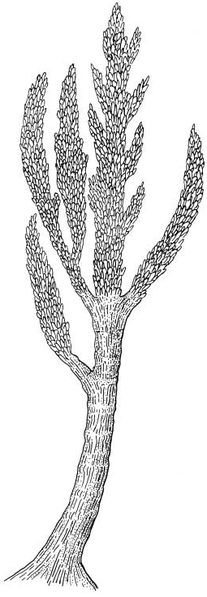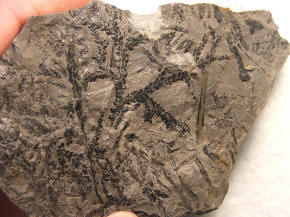By Middle Devonian, shrub-like forests of primitive plants existed: lycophytes, horsetails, ferns, and progymnosperms had evolved. Most of these plants had true roots and leaves, and many were quite tall. The earliest known trees, from the genus Wattieza, appeared in the Late Devonian around 380 Ma. In the Late Devonian, the tree-like ancestral fern Archaeopteris and the giant cladoxylopsid trees grew with true wood. These are the oldest known trees of the world's first forests. By the end of the Devonian, the first seed-forming plants had appeared. This rapid appearance of so many plant groups and growth forms has been called the "Devonian Explosion".
The 'greening' of the continents acted as a carbon dioxide sink, and atmospheric levels of this greenhouse gas may have dropped. This may have cooled the climate and led to the late Devonian extinction event.
Prototaxites
The genus Prototaxites
describes terrestrial organisms known only from fossils dating from the Silurian/Devonian,
approximately 420 to 370 million years ago.
Prototaxites formed large trunk-like structures
up to 1 m (3 ft) wide, reaching 8 m (26 ft) in height, made up of interwoven
tubes just 50 μm in diameter. Whilst traditionally very difficult to assign
to an
extant group of
organisms, current opinion is converging to a
fungal placement for
the genus. It might have had an
algal
symbiont, which would
make it a
lichen rather than a
fungus in the strict sense.
dating from the Silurian/Devonian,
approximately 420 to 370 million years ago.
Prototaxites formed large trunk-like structures
up to 1 m (3 ft) wide, reaching 8 m (26 ft) in height, made up of interwoven
tubes just 50 μm in diameter. Whilst traditionally very difficult to assign
to an
extant group of
organisms, current opinion is converging to a
fungal placement for
the genus. It might have had an
algal
symbiont, which would
make it a
lichen rather than a
fungus in the strict sense.
An opposing view has been presented showing that Prototaxites remains were not trees but consisted of enrolled liverwort mats with associated cyanobacteria and fungal tubular elements.
With a diameter of up to a meter, and a height reaching 8 m, Prototaxites fossils are by far the largest from its period of existence. Viewed from afar, the fossils take the form of tree-trunks, spreading slightly near their base in a fashion that suggests a connection to unpreserved root-like structures. Infilled casts which may represent the "roots" of Prototaxites are common in early Devonian strata. ; Concentric growth rings, sometimes containing embedded plant material, suggest that the organism grew sporadically by the addition of external layers. It is probable that the preserved "trunks" represent the fruiting body, or "sporophore", of a fungus, which would have been fuelled by a net ("mycelium") of dispersed filaments ("hyphae"). On a microscopic scale, the fossils consist of narrow tube-like structures, which weave around one another. These come in two types: skeletal "tubes", 20–50 μm across, have thick (2–6 μm) walls and are undivided for their length, and generative "filaments", which are thinner (5–10 μm diameter) and branch frequently; these mesh together to form the organism's matrix. These thinner filaments are septate – that is to say, they bear internal walls. These septa are perforate - i.e. they contain a pore, a trait only present in the modern red algae and fungi.
The similarity of these tubes to structures in early plant Nematothallus has led to suggestions that the latter may represent leaves of Nematothallus. Unfortunately for this hypothesis, the two have never been found in connection, although this may be a consequence of their detachment after the organisms' death.
This organism would have been the tallest living thing in its day by far; the plant Cooksonia only reached 1 m, and itself towered over the "moss forests"; invertebrates were the only other land-dwelling life. Prototaxites became extinct as shrubs and vascular trees rose to prominence. The organism could have used its raised platform for spore dispersal, or, if Prototaxites really did form leaves, in competition for light. The presence of bio-molecules often associated with the algae may suggest that the organism was covered by symbiotic (or parasitic) algae, or even that it was an alga itself.
Prototaxites mycelia (strands) have been fossilised invading the tissue of vascular plants in turn, there is evidence of animals inhabiting Prototaxites: mazes of tubes have been found within some specimens, with the fungus re-growing into the voids, leading to speculation that the organisms' extinction may have been caused by such activity however, evidence of arthropod borings in Prototaxites has been found from the early and late Devonian, suggesting the organism survived the duress of boring for many millions of years. Intriguingly, Prototaxites is bored long before plants developed a structurally equivalent woody stem, and it is possible that the borers transferred to plants when these evolved.
Lycopodiophyta
The Division Lycopodiophyta (sometimes called Lycophyta or Lycopods) is a tracheophyte subdivision of the Kingdom Plantae. It is the oldest extant (living) vascular plant division at around 427 million years old, and includes some of the most "primitive" extant species. These species reproduce by shedding spores and have macroscopic alternation of generations, although some are homosporous while others are heterosporous. Members of Lycopodiophyta bear a protostele, and the sporophyte generation is dominant. They differ from all other vascular plants in having microphylls, leaves that have only a single vascular trace (vein) rather than the much more complex megaphylls found in ferns and seed plants.
The members of this division have a long evolutionary history, and fossils are abundant
 |
|
Lycopodites, an early lycopod-like fossil. |
Fossils ascribed to the Lycopodiophyta first appear in the Silurian period, along with a number of other vascular plants, and became abundant in the Devonian. Phylogenetic analysis places them at the base of the vascular plants; they are distinguished by their microphylls and by transverse dehiscence of their sporangia (as contrasted with longitudinal in other vascular plants). Sporangia of living species are borne on the upper surfaces of microphylls (called sporophylls). In some groups, these sporophylls are clustered into strobili.
During the Carboniferous period, tree-like Lycopodiophyta (such as Lepidodendron) formed huge forests and dominated the land. Unlike modern trees, leaves grew out of the entire surface of the trunk and branches, but would fall off as the plant grew, leaving only a small cluster of leaves at the top. Their remains formed many fossil coal deposits. In Fossil Park, Glasgow, Scotland, fossilized Lycopodiophyta trees can be found in sandstone. The trees are marked with diamond-shaped scars where they once had leaves.
End of Reading
Return to the Old Earth Ministries Online Earth History Curriculum homepage.
![]()
Source: Devonian, Prototaxites, Lycophyte